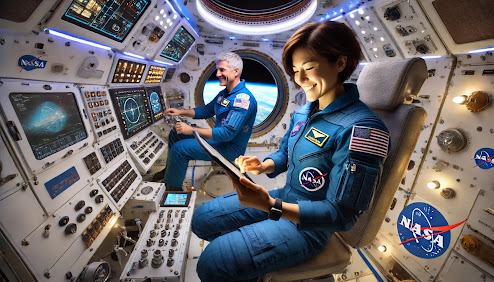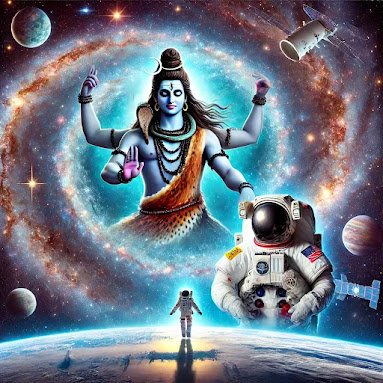Sunita Williams' (Return to Earth) Space Odyssey and the Mystical 14 Lokas: Bridging Modern Space Exploration with Hindu Cosmology
Sunita Williams' Space Odyssey and the Mystical 14 Lokas: Bridging Modern Space Exploration with Hindu Cosmology
Sunita Williams' Return to Earth: A Modern Cosmic Journey
On June 22, 2024, astronaut Sunita Williams made headlines as she returned to Earth after a remarkable 9-month mission aboard Boeing’s Starliner spacecraft. The mission was part of NASA’s effort to establish long-term human presence in space. Sunita, along with her colleague Barry "Butch" Wilmore, spent over 270 days conducting scientific research, maintaining the spacecraft, and adapting to the microgravity environment of space.
Why Sunita Stayed for 9 Months
The Starliner mission faced technical challenges, including issues with the propulsion system and minor hardware failures. NASA extended the mission to address these challenges and to study the long-term effects of microgravity on the human body. Sunita and Barry contributed to research on:
- Human adaptability in microgravity
- Impact of long-duration spaceflight on muscles and bones
- Psychological effects of isolation and confinement
Life in Space: What Sunita Ate and How It Was Prepared
Living in space for 9 months required precise meal planning. Sunita's diet consisted of:
- Rehydratable foods – Freeze-dried vegetables, fruits, and meats
- Thermostabilized foods – Ready-to-eat curries, soups, and stews
- Special supplements – Vitamins and protein-rich bars to prevent muscle loss
- Beverages – Water recycled from moisture in the air and urine, purified through advanced filtration systems
She adapted to microgravity by securing her meals with Velcro and consuming them through squeezable pouches.
Challenges of Space Life
- Lack of gravity caused muscle atrophy and bone loss
- Increased radiation exposure required protective shielding
- Psychological stress from isolation was managed through virtual family calls and meditation
Introduction: Cosmic Travel in Hindu Mythology
- Rig Veda – (10.90.14) – Mentions the existence of multiple realms
- Bhagavata Purana – (Canto 5) – Provides detailed descriptions of the Lokas and their cosmic significance
- Shiva Purana – Describes Shiva as the supreme consciousness connecting all realms
The 14 Lokas – Realms of Existence
In Hindu cosmology, the universe is divided into 14 Lokas—7 higher realms (heavens) and 7 lower realms (underworlds). Each realm is ruled by different deities and beings, with unique characteristics and spiritual significance.
Higher Lokas (Heavens)
- Satyaloka – The realm of Brahma (highest plane of truth and creation)
- Tapoloka – The realm of ascetics and yogis
- Janoloka – The realm of sages and saints
- Maharloka – The realm of enlightened beings
- Swargaloka – Indra’s heaven, realm of pleasures
- Bhuvarloka – The realm of demi-gods and celestial beings
- Bhurloka – The earthly realm (where humans live)
Lower Lokas (Underworlds)
- Atala – Ruled by Bala (son of Maya)
- Vitala – Ruled by Hara-Bhava (a form of Shiva)
- Sutala – Ruled by Mahabali
- Talatala – Realm of Maya’s illusions
- Mahatala – Realm of the serpent Nagas
- Rasatala – Realm of demons
- Patala – The lowest realm, ruled by Vasuki (the serpent king)
Shiva is said to dwell in Mount Kailash, which is believed to transcend the physical Lokas, representing the bridge between the earthly and divine realms. The Lingodbhava story in the Shiva Purana explains how Shiva manifested beyond all cosmic layers, making Him the ultimate source of creation and destruction.
Parallels with Modern Space Exploration
Just as Sunita Williams traveled between Earth and space, ancient seers believed that enlightened beings could traverse between Lokas through spiritual mastery. Hindu texts describe celestial travel in terms of:
- Astral Projection – The soul traveling beyond the body (like astronauts in space)
- Siddhis – Yogic powers enabling movement through cosmic realms
- Garuda and Vimana – Flying vehicles used by gods, resembling modern spacecraft
- Arjuna’s Journey – In the Mahabharata, Arjuna travels to Swargaloka on the divine chariot to meet Indra
- Shiva’s Cosmic Dance – The Tandava symbolizes the rhythmic movement of the universe, similar to planetary orbits and cosmic cycles
Spiritual Significance of Cosmic Travel
In Hinduism, traveling to higher Lokas is associated with:
- Attaining higher knowledge
- Overcoming material limitations
- Understanding the true nature of existence
Modern astronauts, like Sunita Williams, experience a similar spiritual transformation through the experience of cosmic vastness, weightlessness, and the realization of Earth’s fragility.
Science and Spirituality United
Sunita Williams’ journey to space reflects humanity’s eternal quest for knowledge and connection with the cosmos. Just as the ancient sages sought to travel between the Lokas for spiritual growth, modern astronauts explore the vast universe for scientific understanding. The parallels between ancient Hindu cosmology and modern space exploration reinforce the idea that science and spirituality are two sides of the same coin.
The universe is whispering its secrets—are you ready to listen?
Dare to know more? Enter the realm of cosmic truth.
At the end of this journey, you will never see reality the same way again. Are you ready to break the illusion? Deep dive into www.rudradoota.com









0 Comments:
Post a Comment
Subscribe to Post Comments [Atom]
<< Home